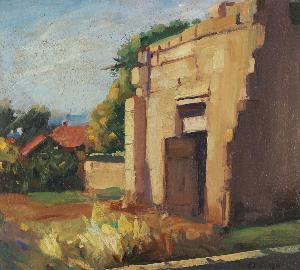Omar Ansi
Omar Ansi;Omar Onsi
paikka: Beirut
Syntynyt: 1901
kuolema: 1969
Elämäkerta:
Omar Onsi, a Lebanese painter, is renowned for his impressionist works that have left an indelible mark on the art world. Born in Tallet Al-Khayat, Beirut in 1901, Onsi's artistic journey was shaped by his family's background and his exposure to Western art.
Early Life and Training
Onsi's father, Dr. Abdul Rahman El Ounsi, was a prominent general practitioner who had studied modern Western medicine. This exposure to Western culture and ideas played a significant role in shaping Onsi's artistic style. After attempting to study medicine, Onsi turned to painting, studying under Khalil Saleeby at his atelier across the street from Beirut University.
Artistic Career
Onsi's career as an artist was marked by several key milestones. In 1922, he traveled to Amman in Jordan, where he settled for a number of years and taught painting and English to the children of King Abdullah. This period had a significant influence on his work, as he discovered the desert and its colors, which became a major theme in his paintings. Onsi also documented the indigenous peoples of the region, both ethnographically and visually. In 1928, Onsi went to Paris to continue his training, attending the Académie Julian and different workshops. During this period, he focused on painting portraits, nudes, and Parisian scenery. He met several notable artists, including Georges Cyr and Youssef El-Houwayek, with whom he became lifelong friends.
Notable Works and Style
Onsi's work is characterized by his use of vibrant colors and his ability to capture the essence of Lebanese landscapes. Some of his notable works include Oil On Panel, which showcases his mastery of impressionist techniques. His paintings often featured gazelles, which became a prominent symbol in his art. Onsi's style was influenced by his exposure to Western art and his own cultural heritage. He is regarded as one of the pioneers of modern painting in Lebanon, along with other notable artists such as Mustafa Farrukh, César Gemayel, Saliba Douaihy, and Rachid Wehbi.
Legacy and Exhibitions
Onsi held his first solo exhibition at the School of Arts and Crafts in Beirut in 1932. He continued to exhibit his work throughout his career, showcasing his paintings in Germany, Spain, Italy, and Egypt. Onsi's legacy as a pioneer of modern painting in Lebanon is still celebrated today, with his works being featured in various museums and galleries, including the Académie Julian.
- Impressionist techniques: Onsi's use of vibrant colors and ability to capture the essence of Lebanese landscapes.
- Cultural heritage: Onsi's exposure to Western art and his own cultural heritage, which influenced his style.
- Pioneering spirit: Onsi's role as a pioneer of modern painting in Lebanon, along with other notable artists.
Onsi's artistic journey is a testament to the power of cultural exchange and the impact of Western art on Lebanese painting. His legacy continues to inspire artists today, and his works remain a vital part of Lebanon's rich cultural heritage. For more information on Omar Onsi and his works, visit Omar Ansi | Wikioo.org. You can also explore the world of art at Wikioo.org, which features a vast collection of artworks and artist biographies.

